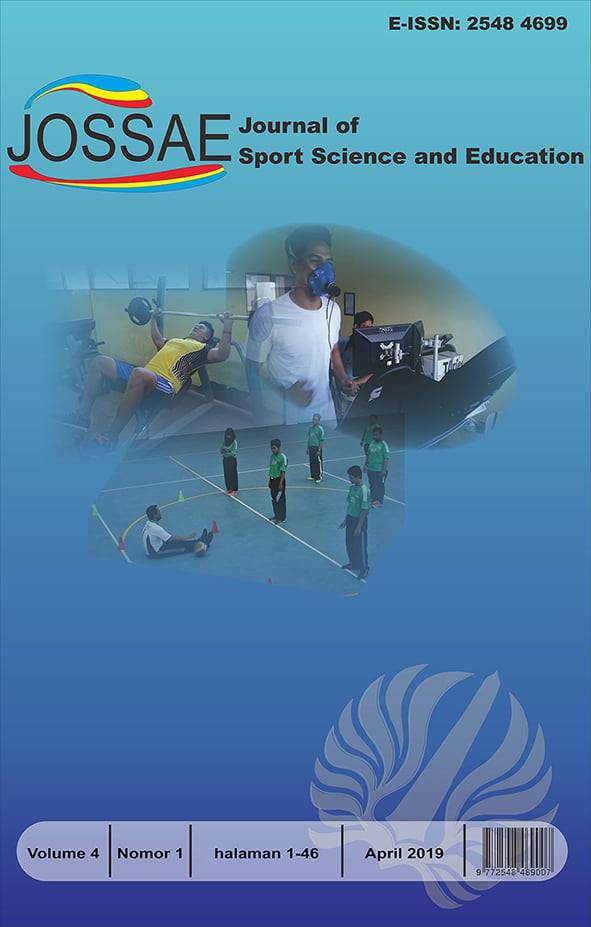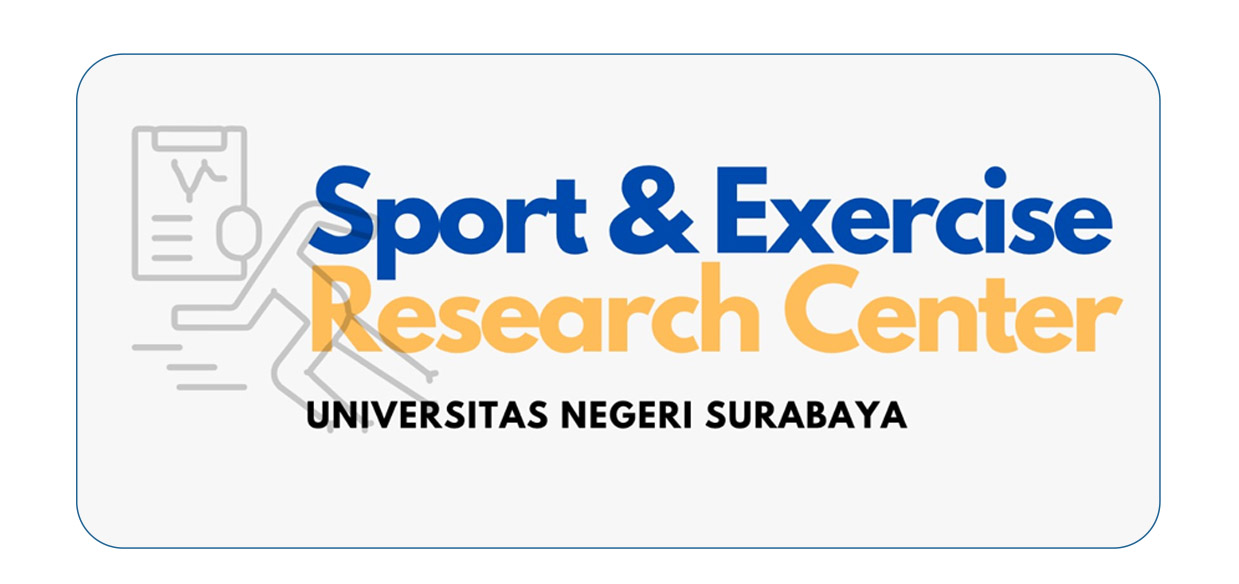Hubungan Antara Pola Makan Dan Status Gizi Dengan Tingkat Kebugaran Atlet Dayung
DOI:
https://doi.org/10.26740/jossae.v4n1.p14-20Keywords:
relationship, diet, nutritional status, level of physical fitness athlete rowingAbstract
The purpose of this study is to obtain a broader picture of the relationship between diet and nutritional status with the level of physical fitness of rowing athletes in western district regency. The method used by quantitative descriptive method, the participants involved in this research are rowing athletes of west bandung regency, X1 dietary food diet 2x24 hours, X2 nutritional status calculation of body mass index (imt) and Y level of cooper test, with correlation and test contribution using regression test. The results of the first hypothesis test shows the value of X1 counts of 0.174> (0.05) (10). The result of the second hypothesis X2 test shows the value of 0.603> (0.05) (10), it can be concluded there is no significant relationship between diet and nutritional status with physical fitness level athletes paddle west bandung regency. Based on the results of regression analysis X1 contribution X2 & Y obtained value R = 0.476, with R square value of 0.227 it can be concluded that Ho accepted. This shows there is no significant relationship between diet and nutritional status with fitness level. While the value of R square addressed the percentage of values that consider the effect of X to Y of 22.7%, while the rest of 73.3% influenced by other factors. Can be concluded there is no relationship between diet and nutritional status with the level of physical fitness athletes rowing district west bandungReferences
Assessment, A., & Intake, C. (1995). An Assessment of Carbohydrate Intake, 206214.
Baranauskas, M., Stukas, R., Tubelis, L., Žagminas, K., Å urkiene, G., Å vedas, E., ¦ AbaraviÄius, J. A. (2015). Nutritional habits among high-performance endurance athletes. Medicina (Lithuania), 51(6), 351362. https://doi.org/10.1016/j.medici.2015.11.004
Basiotis, P.B. et al. J. Nutr., 117, & 1638, 1987. (n.d.). Basiotis, P.B. et al. Estimate, Number of Days of Food Intake Records Required to Confidence. Individual and Group Nutrient Intakes with Defined.
Benardot, D. (2012). Advanced Sports Nutrition, 424. Retrieved from http://books.google.com/books?hl=en&lr=&id=w0Zel_bJn-EC&oi=fnd&pg=PR1&dq=Advanced+Sports+Nutrition&ots=fmkK1chfgh&sig=5AJy34YQwPQq84WzuhgTgN48_BU
DepKes, R. I. (1994). Pedoman Sanitasi Rumah Sakit di Indonesia. Direktorat Jenderal P2M & PLP Dan Direktorat Jenderal Pelayanan Medik, Jakarta.
F.D., W. (1994). Health services utilization among older adults: Conceptual, measurement, and modeling issues in secondary analysis. Gerontologist, 34(4), 470475. Retrieved from http://ovidsp.ovid.com/ovidweb.cgi?T=JS&PAGE=reference&D=emed3&NEWS=N&AN=1994318854
Irawan, M. A. (2007). Nutrisi, Energi, & Performa olahraga. Polton Sport Science & Performance Lab, 1, 113.
Irianto, D. P. (2002). œPedoman praktis berolahraga untuk kebugaran dan kesehatan. Yogyakarta: Andi Offset.
Irianto, D. P. (2007). œPanduan gizi lengkap keluarga dan olahragawan. Yogyakarta¯; Andi Offset.
James, W. P. T., Ferro-Luzzi, A., & Waterlow, J. C. (1988). Definition of Chronic Deficiency in Adults - Report of a Working Party of the International Dietary Energy Consultative Group. European Journal of Clinical Nutrition, 42(12), 969981.
Pollock, M. L., Bohannon, R. L., Cooper, K. H., Ayres, J. J., Ward, A., White, S. R., & Linnerud, A. C. (1976). A comparative analysis of four protocols for maximal treadmill stress testing. American Heart Journal, 92(1), 3946.
Sandrawaty, M. (2016). PENGARUH PEMBELAJARAN PERMAINAN HOKI KEPERCAYAAN DIRI SISWA DI SMA NEGERI 26 GARUT. Jurnal Terapan Ilmu Keolahragaan, 1(2), 5963.
Sharkey, Brian J., Gaskill, S. (2013). Fitness & Health 7th Edition.
Sugiyono, M. P. K. (2013). Kualitatif, dan Kombinasi (Mixed methods). Bandung: Alfabeta.
Supariasa, I. Dewa Nyoman, Bachyar Bakri, and I. F. (2002). Penilian Status Gizi. Jakarta: EGC.
Wiita, B.G. and Stombaugh, I. . (n.d.). Nutrition knowledge, eating practices and Runners, health of adolescent femalea 3-year longitudinal study. Int. J. Sport.
Zalcman, I., S, M., Guarita, H. V., D, R., Juzwiak, C. R., Ph, D., ¦ Ph, D. (2007). Nutritional status of adventure racers, 23, 404411. https://doi.org/10.1016/j.nut.2007.01.001
Baranauskas, M., Stukas, R., Tubelis, L., Žagminas, K., Å urkiene, G., Å vedas, E., ¦ AbaraviÄius, J. A. (2015). Nutritional habits among high-performance endurance athletes. Medicina (Lithuania), 51(6), 351362. https://doi.org/10.1016/j.medici.2015.11.004
Basiotis, P.B. et al. J. Nutr., 117, & 1638, 1987. (n.d.). Basiotis, P.B. et al. Estimate, Number of Days of Food Intake Records Required to Confidence. Individual and Group Nutrient Intakes with Defined.
Benardot, D. (2012). Advanced Sports Nutrition, 424. Retrieved from http://books.google.com/books?hl=en&lr=&id=w0Zel_bJn-EC&oi=fnd&pg=PR1&dq=Advanced+Sports+Nutrition&ots=fmkK1chfgh&sig=5AJy34YQwPQq84WzuhgTgN48_BU
DepKes, R. I. (1994). Pedoman Sanitasi Rumah Sakit di Indonesia. Direktorat Jenderal P2M & PLP Dan Direktorat Jenderal Pelayanan Medik, Jakarta.
F.D., W. (1994). Health services utilization among older adults: Conceptual, measurement, and modeling issues in secondary analysis. Gerontologist, 34(4), 470475. Retrieved from http://ovidsp.ovid.com/ovidweb.cgi?T=JS&PAGE=reference&D=emed3&NEWS=N&AN=1994318854
Irawan, M. A. (2007). Nutrisi, Energi, & Performa olahraga. Polton Sport Science & Performance Lab, 1, 113.
Irianto, D. P. (2002). œPedoman praktis berolahraga untuk kebugaran dan kesehatan. Yogyakarta: Andi Offset.
Irianto, D. P. (2007). œPanduan gizi lengkap keluarga dan olahragawan. Yogyakarta¯; Andi Offset.
James, W. P. T., Ferro-Luzzi, A., & Waterlow, J. C. (1988). Definition of Chronic Deficiency in Adults - Report of a Working Party of the International Dietary Energy Consultative Group. European Journal of Clinical Nutrition, 42(12), 969981.
Pollock, M. L., Bohannon, R. L., Cooper, K. H., Ayres, J. J., Ward, A., White, S. R., & Linnerud, A. C. (1976). A comparative analysis of four protocols for maximal treadmill stress testing. American Heart Journal, 92(1), 3946.
Sandrawaty, M. (2016). PENGARUH PEMBELAJARAN PERMAINAN HOKI KEPERCAYAAN DIRI SISWA DI SMA NEGERI 26 GARUT. Jurnal Terapan Ilmu Keolahragaan, 1(2), 5963.
Sharkey, Brian J., Gaskill, S. (2013). Fitness & Health 7th Edition.
Sugiyono, M. P. K. (2013). Kualitatif, dan Kombinasi (Mixed methods). Bandung: Alfabeta.
Supariasa, I. Dewa Nyoman, Bachyar Bakri, and I. F. (2002). Penilian Status Gizi. Jakarta: EGC.
Wiita, B.G. and Stombaugh, I. . (n.d.). Nutrition knowledge, eating practices and Runners, health of adolescent femalea 3-year longitudinal study. Int. J. Sport.
Zalcman, I., S, M., Guarita, H. V., D, R., Juzwiak, C. R., Ph, D., ¦ Ph, D. (2007). Nutritional status of adventure racers, 23, 404411. https://doi.org/10.1016/j.nut.2007.01.001
Downloads
Published
2019-08-31
How to Cite
Muharam, R. R. (2019). Hubungan Antara Pola Makan Dan Status Gizi Dengan Tingkat Kebugaran Atlet Dayung. JOSSAE (Journal of Sport Science and Education), 4(1), 14–20. https://doi.org/10.26740/jossae.v4n1.p14-20
Issue
Section
Articles
 Abstract views: 4940
,
Abstract views: 4940
, PDF Downloads: 12767
PDF Downloads: 12767









